
The growth of the cabling industry has been well documented over the last 10 years. Two of the major reasons ones are:
|
|
|||||||
Aesthetics of the structured cabling system are difficult to quantify. The standards address this issue in passing, with few directions to the end user who uses this system. Are aesthetics really important?
Aesthetics are a component of the system functional performance level, which measures the true performance of a system. System functional performance level (Fig. 2) can be broken down, similar to a three-legged stool, into three interdependent elements:

The 568-A mentions in "Cabling Practices, Telecommunication Closets," section 7.4 and Equipment section 8.4: "Appropriate cable routing and dressing fixtures should be used for effective organization and management of the different types of cables in telecommunications closets."
The 11801 addresses this issue in "Connecting Hardware Requirements, Installation Practices," section 9.1.6. "The manner and care with which the cabling is implemented are a significant factor in performance and ease of administration of installed cabling systems."
Below are some examples of typical situations that demonstrate the importance of aesthetics (or the lack thereof):
You have been involved in the installation of a brand-new cabling plant. All the components tested well, and the installation firm did a great job. However, two years later "Frank" moves to another office. You have patch Frank to his new office. It takes a few minutes to pick out the patch cord in the "rat's nest." Then it takes a few more minutes to search out the appropriate color and length patch cord from the inventory spread across the floor in little piles. After a thorough search, you find that you need a five-footers and have to use a seven-footer. Rather than order a new cord, you make do. After all, you have 10 more move orders to fill.
The bottleneck to the functional performance level of the entire system in this case is due directly to aesthetics. Extra time (and money) is involved, as well as the cost for mistakes. According to LAN Technology, "Seventy percent of network downtime is cable related." With the industry awareness to the standards and installation practices these days, you can be sure that some of this downtime is due to aesthetics.
Besides affecting the functional performance level, aesthetics can create an impact on the emotional level. This has been detrimental to the industry.
A Fortune 1000 company is relocating its corporate headquarters and is interviewing prospective Systems Integrators to handle its information systems relocation. This includes the design and installation of a structured cabling plant. "Dana," the president of Acme Integration, gives the grand tour of her firm's impressive facilities.
Unfortunately, one of the visitors walks over to the "spaghetti mess" that is Acme's patch panel system. The rest of the group wanders over, scribbling notes in their notepads. The MIS Director of the Fortune 1000 firm says as he leaves, "We'll give you a call." He never does.
Even in its relative infancy, the cabling industry has been an important discipline that is integral to today's business. Unfortunately, the perception of the cabling industry from the outside is many times one of the "Joe Six-Pack" mentality. Joe Six-Pack is a rather disheveled individual who leaves fingerprints on ceiling tiles, and trash in whatever area he was last working in. He is responsible for the rat's nest in the company computer room.
The myth of Joe Six-Pack is more than a funny misconception. It is a justification to treat the cabling industry with less respect than other disciplines. Ultimately, it is possible that this "lack of respect" could be translated to a "lack of fair compensation" to the men and women of the cabling industry.
Last year I wrote a piece in this space about 1996 being the "Year of the Installer." That moniker fulfilled itself as BICSI rolled out an impressive Cabling Installation program and TIA/EIA started an Installation Requirements Task Group. It is time for the leaders in the industry, including BICSI, TIA/EIA, ISO/IEC, manufacturers, installers, and end users, to work as a team and make 1997 the "Year of Aesthetics." (Click here to go to the BICSI home page.)
 |

|
As the demand for high-speed enterprise networks has increased, so has the need for high-density modular patch panels and the patch cords that populate them. And with the limited space available in wiring closets and equipment rooms, the need for patch-cord management systems is greater still.
While cabling standards such as TIA/EIA-568A and the international standard ISO/IEC-11801 have addressed many cabling issues, they pay little attention to the most disorganized part of any cabling infrastructure: the patch-cord management system.Often described by such terms as "rat's nest," "spaghetti," and "jungle," the working patch panel is both an eyesore to visitors and an invitation to networking problems for installers and maintainers (see figure 1).
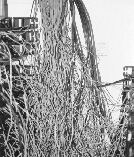 |
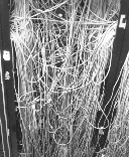 |
 |
| Figure 1. Patch Cord Management in the "Real World." | ||
| To examine the state of the patch-cord management systems, Concert Technologies (Dulles, VA), a network infrastructure consulting and services firm, conducted a study of 20 sites in the Washington, DC, area during eight months in 1996. To qualify for the study, a site had to have at least 100 unshielded twisted-pair (UTP) or screen twisted-pair (ScTP) modular patch cords attached to a single or adjacent racks or cabinets. The sites included government installations (50%), systems integrators (15%), law firms (15%), accounting firms (10%), and commercial establishments (10%) (see figure 2). |  Figure 2. Breakdown of Sites Studied by PerfectSite. |
During the study, the Concert Technologies inspection team examined 473 patch panels in 87 wiring closets. In all, 16,242 patch cords were inspected, along with 723 horizontal patch-cord managers and 1066 vertical managers. Hook-and-loop (or Velcro(r)) and tie-wrap devices, used in 41 of the closets, were classified as to the horizontal and vertical systems with which they were used (see figure 3).

The study consisted of random selection and examination of the 1624 patch cords, 10% of the total, for a statistical accuracy level of ±3%.
The examinations conducted by the inspection team showed that the patch cords-which, for the purpose of the study, were defined as flexible cables with modular plugs on each end that are used to establish connections between patch panels and equipment-could be divided into four categories, as follows:
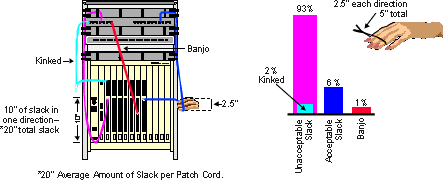
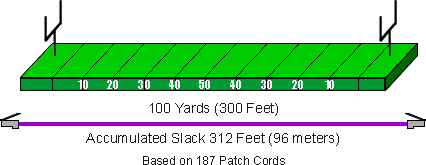
"The number-one problem in patch-cord management today is excessive slack," says Herbert Mendelsohn, a retired communication specialist, formerly with the U.S. Department of Agriculture and now an industry advisor. The problem occurs because patch cords are manufactured in one-foot increments rather than to length. Moreover, when companies stock many different lengths in inventory, they commonly use an overly long cable when the correct length is out of stock. Also, when in doubt, cable-plant managers typically order cords that are too long, since cables that are too short are virtually useless.
"Another problem," adds Mendelsohn, "is something I call 'the entangling effect.' This phenomenon occurs when someone relocates a patch cord and, instead of pulling it out completely and starting over, he or she simply unplugs the patch cord and sticks it into the new port atop the other cables."
Other findingsThe Concert Technologies study also shed light on a number of other patch-cord issues. For example, should you rely on manufactured patch cords or make your own? Only 3 of the 20 sites surveyed made their own, while 85% depended on manufactured patch cords. Manufactured cords were preferred because they were thought to be more reliable, and even those sites that made their own were discontinuing the practice because of the high data rates the cords were expected to carry, the lack of experienced labor to make them, and the unmet need for quality assurance. Ironically, hand-made cords generally had the same amount of slack as manufactured patch cords. At the time of first use they may have been cut to exact length, but over time these cords were moved around and so the advantage of custom fit was lost.
Another area of concern has been bend radius. Many industry practitioners mistakenly apply Section 10.6.3.2 of TIA/EIA-568A to patch cables. The standard calls for a bend-radius of "not less than four times the cable diameter for horizontal (UTP) cable," and by extension the same limit is applied to ScTP cable in Section 10.2.1. However, this restriction only applies to the termination of horizontal cable runs at the back of the patch panel, and not to the patch cords found at the front.
In the international standard, the patch cord is included in the bend-radius requirement set forth in Section 9.1.6-four times the diameter of the outer cable. However, the requirement is marked "f.f.s." (for further study), which means that it is not required for conformance to the ISO/IEC 11801 standard, since adequate data has not been presented to the scientific community. Only 7% of the patch cords surveyed by Concert Technologies had bend radiuses four times the outer-cable diameter.
| Another issue in this area is bend-radius stability. Unlike the situation in horizontal cable runs, where the cable is stable once installed, patch cords may be moved constantly. A patch cord measured for study on one day may have a different bend radius, or even be kinked, the next day. This situation obviously does not apply to the back of the patch panel, where horizontal cabling can be secured from movement (see figure 6). | 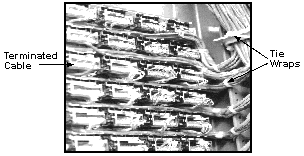 |
Horizontal and vertical patch-cord management systems also affect bend radius. For example, the study found three types of horizontal patch-cord management in use, each of which affected bend radius differently. Distribution rings were the most common way of directing the patch cords from the patch panel to the vertical management system. Routing clips were used at some sites. Smaller than distribution rings, they could be more densely populated on the horizontal manager, allowing a straighter patch. The third type of horizontal manager was the channel or duct (see figure 7).
 |
 |
 |
||
| Figure 7. Patch-Cord Managers. | ||||
The distance between the end of the distribution ring , routing clip, or channel and the patch panel was an important factor affecting bend radius. The shallow depth of the distribution rings, for instance, led to smaller patch-cord bend radius. The shallowest measurement was found, however, on cords directed into routing clips; here depth was typically 0.5 to 1.25 inches. (see figure 8).

| If a strain relief or boot was present, the bend might be sharpened even more when directing the patch cord into, say, a 1-inch routing clip (see figure 9). Patch panels from some manufacturers also extended 0.5-inch out from their horizontal plane, further reducing the distance between the distribution ring and patch panel. |  |
| Figure 9. Strain Relief or Boot Contributes to Bend Radius. |
A vertical patch-cord management system usually consisted of either brackets or channels. The brackets came in many sizes and shapes (see figure 10), but were often comparable in size to their horizontal counterparts, even though required to handle many more cables (see figure 11). Channels, because they are more restrictive, showed by far the most problems when it came to bend radius and cable slack (see figure 12). (Cabinets also exhibited more problems than racks with bracket managers for the same reason: Their restrictiveness lowered bend radius and made slack more difficult to deal with.)
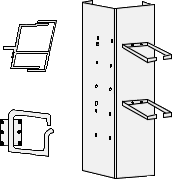 Figure 10. Vertical Brackets. |
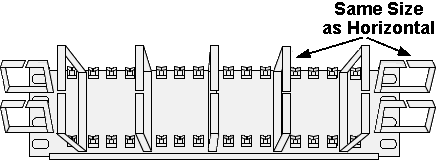 Figure 11. Vertical Bracket. |
 Figure 12. Vertical Channel. |
Vertical management systems were clearly more problematic than horizontal ones. The Concert Technologies study showed that many vertical management systems were simply incapable of accommodating the amount of cable slack accumulated in the patching system.
However, bend-radius problems were not as prevalent as those encountered in horizontal management systems, although 32 cases of kinking were recorded. This was because of the great accumulation of slack that had built up over time in vertical systems, along with the entangling effect described above. Also, vertical systems were more likely to have patch cords tightly crammed into them, creating a situation best described as "overfilling."
Supplemental support from the hook-and-loop or cable-tie systems has improved substantially over the last two years, but none of the sites studied used these methods as their sole provider of support. In fact, Velcro(r) strips or plastic tie wrappers were more often used in desperation just to keep patch cords out of the way. In each case where such devices were employed, it took longer to identify a patch cord because it was first necessary to remove the Velcro strip or tie wrap (see figure 13).
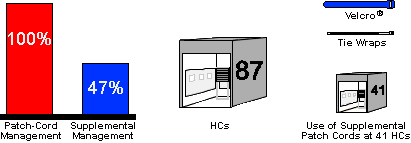
The Concert Technologies study indicates that high-density patching using conventional patch cords and panels is inadequate for the demands of a commercial environment, even though the sites surveyed had ample horizontal and vertical patch-cord management systems.
In almost every case, these installations violated the spirit, if not the letter, of applicable national and international standards. For example, Section 8.4 of TIA/EIA-568A states: "Appropriate cable routing and dressing fixtures should be used for effective organization and management of the different types of cables in telecommunications closets." ISO-IEC-11801, in Section 9.1.6, provides similar guidance: "The manner and care with which the cabling is implemented are significant factors in performance and ease of administration of installed cabling systems."
The problems with patch-cord management today-the accumulation of excessive slack in standard-length manufactured cords and the entangling effect that turns them into "spaghetti" over time-will not be solved by handmade patch cords. As we have seen, such cords may eventually experience the same problems as manufactured items, and they suffer the additional problem of uncertain, inconsistent, or degraded performance.
This has lead patch-cord users to cast about for other solutions to these problems. One alternative that some firms are using is to terminate one end of the patch cord on a punchdown block, while the other end is terminated in the traditional way, with a connector that fits into the equipment (concentrator). The patch cord punchdown block connects to the horizontal cabling system through a crossconnect field. Creating such a crossconnect field permits you to cut your patch cords to the proper length for each connection (see figure 16).
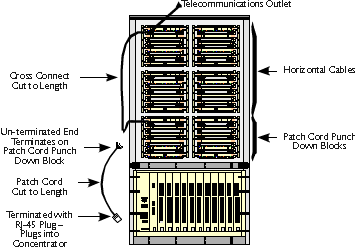
However, such a solution may be in violation of TIA/EIA-568A if the manufacturer's punchdown block does not accept stranded cable. The cabling standard currently calls for using stranded patch cords in this application, although solid-wire patch cords are being examined for possible inclusion in an addendum to the standard.
What is certain is that the patch-cord problem is real, and it is important. According to Datapro Information Services Group, "Physical management problems account for 50% of network problems and downtime." At least some, and perhaps much, of this downtime results form problems with patch cords.
Why don't such problems get addressed? A recent survey suggests an answer to this question. Several years ago, Computerworld magazine surveyed 361 information-systems professionals and generated a list of the Top 10 Worst Jobs in Information Systems. Second on their list was troubleshooting cabling. "It is an especially frustrating and time-consuming task," the article said.
| However, surveys alone are not enough to define the problem. One of us at Concert Technologies served as an expert witness in a civil case not long ago. The litigation revolved around a patient with a history of heart trouble who died in a hospital's cardiac care unit. The patient's bedside heart monitor registered the problem, but the audible signal failed, and the redundancy system connected to the nurse's station also failed. It was found that one of the problems leading to the failure of the hospital's monitoring and alarm system was an incorrect patch in the wiring to the nurse's station. The technician who maintained the cabling system said that the incorrect patch was made because he couldn't tell what he was doing at the patch panel because of the "mess of all those cables everywhere." In the last decade, the cabling industry has come a long way. Evolving from a conglomeration of proprietary voice- and data-system makers, it is now represented by national standards bodies, industry organizations, and other groups dedicated to its growth and maintenance. One problem that these groups should begin to take seriously is the role of patch cords in horizontal cabling systems-and, by extension, in the integrity of the entire network. Otherwise, those "rat's nests" will continue to plague installers and maintainers of premises and campuswide cabling systems. (Click here to go to the Cabling Installation & Management home page.) |
Why Do Those Model Patch Panels at Trade Shows Look So Good? |
Every once in a while, a company will introduce a product that has everyone asking, "Why did I think of that?" So it is with the brainchild of Dennis Mazaris, President of Concert Technologies, Dulles, VA, 703-796-5408. Who hasn't wrestled with a tangled mass of patch cords of different (or the wrong) lengths? They're hard to work with, and it's impossible to achieve a professional, aethetically attractive installation. The PerfectPatch is a small, plastic device that easily and efficiently takes up excess cord length for a neat, high density installation. PerfectPatch is patent pending and is available through Graybar and Anixter. You can get a complete description of this neat product by checking out the website at www.perfectpatch.com.
Cabling Business, April 1998In the "GOOD THINGS COME IN SMALL PACKAGES" category, the PerfectPatchTM from PerfectPatch, Inc., is a simple plastic clip type device that allows the user to adjust the slack length of each patch cord separately. The PerfectPatchTM is doing a remarkable job of cleaning up the pervasive problem of patch cord clutter...one wiring closet at a time. Check out their very informative and cool website, www.perfectpatch.com. We applaud these creative inventors who solve problems.
| Home | Design & Installation | Programs | Instructions | Distributors | The Developers | Gallery | Questions | Email Us |
| PerfectPatch |